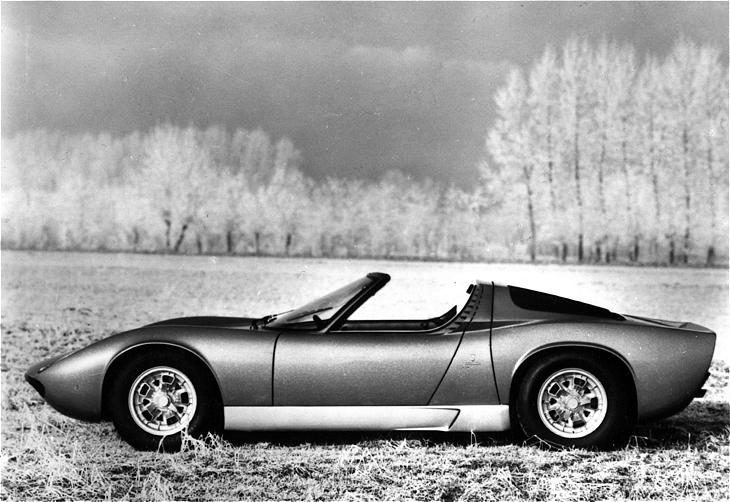Description
The Lamborghini Miura Roadster Bertone was one of the most captivating and mysterious one-off creations in Lamborghini’s history—a car that combined the beauty and engineering brilliance of the Miura with the drama and allure of an open-top design. Built by Carrozzeria Bertone in 1968 as a show car, the Miura Roadster was a stunning exploration of what the world’s most famous mid-engine supercar might look like as a convertible. Although it never reached production, it remains one of the most celebrated and valuable prototypes ever created, a unique expression of Lamborghini’s golden era and Bertone’s design genius.
The idea for the Miura Roadster came from Nuccio Bertone himself. By the late 1960s, the Miura had already made Lamborghini a household name, its sleek design by Marcello Gandini redefining what a supercar could be. Bertone saw an opportunity to build upon this success and to showcase his firm’s design creativity at the highest level. He commissioned Gandini to reimagine the Miura as a roadster—a car that would retain the dramatic proportions of the coupé while introducing an entirely new dimension of style and glamour.
The result was unveiled at the 1968 Brussels Motor Show, and it left an indelible mark on everyone who saw it. The Miura Roadster was more than a simple roofless variant; it was a complete reworking of the Miura’s form. The car featured a lower windscreen, reshaped side windows, and a reinforced structure to compensate for the loss of the roof. The rear bodywork was revised with larger air intakes, broader hips, and a redesigned engine cover to accommodate the changes in airflow and cooling. Its proportions were even more aggressive and athletic than the coupé’s—fluid, yet muscular, with the kind of sculptural presence that seemed to belong more to art than to machinery.
Mechanically, the Miura Roadster used the same 3,929 cc all-aluminium V12 engine as the production Miura P 400, producing 350 horsepower and capable of pushing the car beyond 270 km/h (168 mph). The transversely mounted V12, developed from Giotto Bizzarrini’s original design, was paired with a five-speed manual gearbox and fully independent suspension. The combination promised the same extraordinary performance that had made the Miura the fastest road car in the world, but now with the added thrill of open-air driving.
Despite its spectacular appearance, the Miura Roadster was not designed for production. The lack of a roof introduced structural challenges that were difficult to overcome without adding significant weight, which would have compromised performance. In addition, Lamborghini’s founder, Ferruccio Lamborghini, was focused on perfecting the Miura coupé and had no interest in expanding the lineup with a convertible variant. The Roadster remained a showpiece—a rolling sculpture created to demonstrate Bertone’s artistry and to attract attention to both companies.
After its debut, the Miura Roadster became something of a legend. The car was sold by Bertone to the International Lead and Zinc Research Organization (ILZRO), which used it as a promotional vehicle to showcase the use of zinc, lead, and other metals in automotive manufacturing. The car was completely reworked into what became known as the Zn75, featuring metallic green bodywork, a redesigned interior, and extensive use of zinc alloy components throughout. Though the modifications were technically interesting, they disguised much of the original Miura’s beauty, and the car largely disappeared from public view.
Decades later, enthusiasts and historians began to search for the lost Miura Roadster, which resurfaced in the 1980s in heavily altered form. Fortunately, it was eventually acquired by a private collector who commissioned a painstaking restoration to return it to its original 1968 Brussels show configuration. The work was carried out by the experts at Bobileff Motorcar Company and Gary Bobileff’s team in California, with guidance from Lamborghini historians and Bertone’s archives. Every curve, color, and detail was recreated exactly as it had appeared at its debut, down to its shimmering metallic silver-blue paint and the matching blue-and-white interior.
Today, the Lamborghini Miura Roadster Bertone stands as one of the rarest and most valuable Lamborghinis ever built. Its blend of open-air elegance, technical innovation, and sheer presence make it a one-of-a-kind masterpiece. It represents not only a fascinating “what if” moment in Lamborghini’s history but also a testament to the artistry of Marcello Gandini and Nuccio Bertone at the height of their creativity.
The Miura Roadster remains a symbol of the freedom and imagination that defined the late 1960s—a time when design and performance pushed beyond limits simply for the joy of creation. Though it never entered production, its legacy endures as one of the most beautiful and evocative cars ever built—a singular vision of the Miura’s spirit, distilled into pure elegance and emotion.
